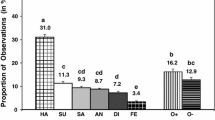Abstract
An experiment was performed to assess whether Ekman and Friesen's Facial Action Coding System (FACS) could be used to construct facial expressions that portrayed with varying intensities each of the eight emotions of happiness, fear, disgust, sadness, surprise, shame, anger, and contempt. Based on detailed instructions from FACS, seven adults posed facial expressions that presumably varied in the conveyed emotion and emotion intensity. Thirty-nine college student observers then viewed each of the videotaped facial expressions. Ratings were made of whether each expression connoted one of the eight emotions or no emotion and of the intensity of the perceived emotion. Observers' emotion classification and intensity ratings agreed with FACS-based predictions regarding the facial action units involved in expressing each of the emotions. Most perceived-predicted emotion discrepancies could be accounted for by facial action units shared by the different emotions. Moreover, except for disgust, observers' intensity judgments reflected a reliance on only one or two action units for each emotion. These findings corroborate the descriptive and predictive utility of FACS for studies on perception of emotions.
Similar content being viewed by others
Reference Note
Ekman, P. Personal communication, September 1979.
References
Bassili, J.N. Facial motion in the perception of faces and of emotional expression.Journal of Experimental Psychology, 1978,4 (3), 373–379.
Bassili, J.N. Emotion recognition: the role of facial movement and the relative importance of upper and lower areas of the face.Journal of Personality and Social Psychology, 1979,37 (11), 2049–2058.
Blurton Jones, N.G. Criteria for use in describing facial expression in children.Human Biology, 1971,41, 365–413.
Camras, L.A. Facial expressions used by children in a conflict situation.Child Development, 1977,48, 1431–1435.
Camras, L.A. Children's understanding of facial expressions used during conflict encounters.Child Development, 1980,51, 879–885.
Ekman, P. Methods for measuring facial action. To appear in: K. Scherer & P. Ekman (Eds.),Handbook on methods of nonverbal communication research. New York, Cambridge Univ. Press, 1981.
Ekman, P., & Friesen, W.V.Unmasking the face. Englewood Cliffs, N.J. Prentice-Hall, 1975.
Ekman, P., & Friesen, W.V. Measuring facial movement.Environmental Psychology and Nonverbal Behavior. 1976,1 (1), 56–75.
Ekman, P., & Friesen, W.V.Manual for the Facial Action Coding System. Palo Alto, California: Consulting Psychologists Press, 1978a.
Ekman, P., & Friesen, W.V.Investigator's Guide to the Facial Action Coding System, part I and II. Palo Alto, California: Consulting Psychologist Press, 1978b.
Ekman, P., & Friesen, W.V.Analyzing Facial Action, Book in preparation.
Ekman, P., Friesen, W.V., & Ancoli, S. Facial signs of emotional experience.Journal of Personality and Social Psychology, 1980,39, (6), 1125–1134.
Ekman, P., Friesen, W.V., & Ellsworth, P.Emotion in the human face: guidelines for research and an integration of findings. New York: Pergamon Press, 1972.
Ekman, P., Friesen, W.V., & Tomkins, S.S. Facial Affect Scoring Technique (FAST): a first validity study.Semiotica, 1971,3 (1), 37–58.
Ekman, P., & Oster, H. Facial expressions of emotion.Annual Review of Psychology, 1979,30, 527–554.
Emde, R.N., Kligman, D.H., Reich, J.H., & Wade, T.D. Emotional expression in infancy: I. Initial studies of social signaling and an emergent model. In M. Lewis & L.A. Rosenblum (Eds.),The development of affect. New York: Plenum Press, 1978.
Frois-Wittman, J. The judgment of facial expression.Journal of Experimental Psychology, 1930,13, 113–151.
Hiatt, S.W., Campos, J.J., & Emde, R.N. Facial patterning and infant emotional expression: happiness, surprise, and fear.Child Development, 1979,50 (4), 1020–1035.
Izard, C.E.The face of emotion. New York: Appleton-Century-Crofts, 1971.
Izard, C.E.Human Emotions. New York: Plenum Press, 1977.
Izard, C.E.The maximally discriminative facial movement coding system (MAX). Newark: University of Delaware Instructional Resources Center, 1979.
Izard, C.E., Huebner, R.R., Risser, D., McGinnes, G.C., & Dougherty, L.M. The young infant's ability to produce discrete emotion expressions.Developmental Psychology, 1980,16 (2), 132–140.
Shye, S. Partial order scalogram analysis. In S. Shye (Ed.),Theory construction and data analysis in the behavioral sciences. San Francisco: Jossey-Bass, Inc., 1978.
Tomkins, S.S., & McCarter, R. What and where are the primary affects? Some evidence for a theory.Perceptual and Motor Skills, 1964,18, 119–158.
Author information
Authors and Affiliations
Additional information
This study forms part of a doctoral dissertation, financially supported by the Netherlands Organization for the Advancement of Pure Research (Z.W.O. grant 56-103). The author wishes to thank Cornelis F.M. van Lieshout, Tamara J. Ferguson, and Michael Katzko for their comments on earlier versions of this manuscript, and Arnold L. van den Wollenberg for his useful suggestion for data analysis. Thanks are extended also to the coders, posers, and observers who participated in this study.
Rights and permissions
About this article
Cite this article
Wiggers, M. Judgments of facial expressions of emotion predicted from facial behavior. J Nonverbal Behav 7, 101–116 (1982). https://doi.org/10.1007/BF00986872
Issue Date:
DOI: https://doi.org/10.1007/BF00986872




